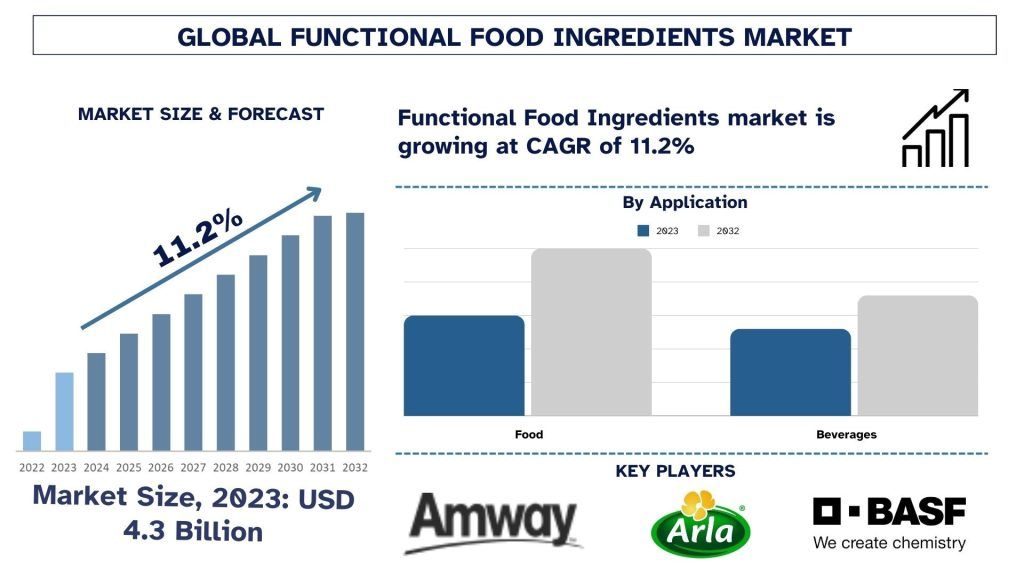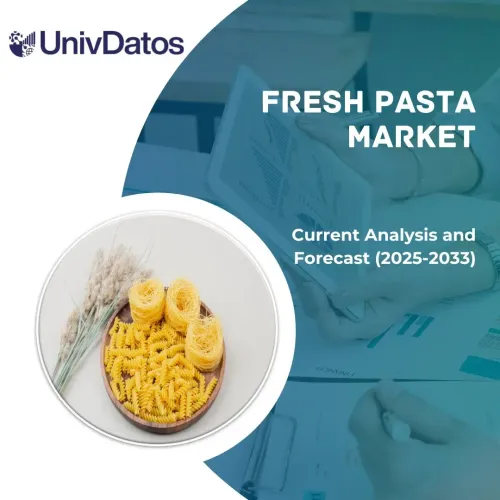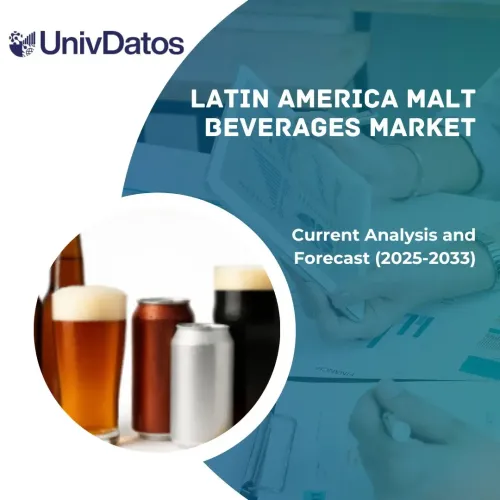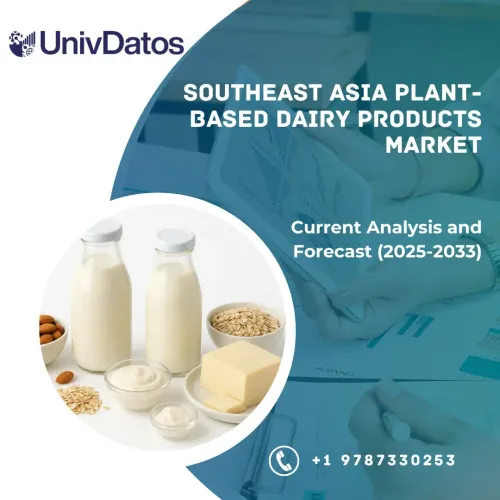- Home
- About Us
- Industry
- Services
- Reading
- Contact Us
Functional Food Ingredients Market: Current Analysis and Forecast (2024-2032)
Emphasis on Type (Probiotics, Proteins & Amino Acids, Phytochemicals & Plant Extracts, Prebiotics, Fibers & Specialty Carbohydrates, Omega-3 Fatty Acids, Carotenoids, Vitamins, and Minerals); Health Benefits (Gut Health, Cardiovascular Health, Bone Health, Immunity, Nutritive Health, Weight Management, Others); Application (Food, Beverages); Source (Natural, Synthetic); Region/Country
Functional Food Ingredients Market Size & Forecast
The Functional Food Ingredients market was valued at approximately USD 4.3 Billion in 2023 and is expected to grow at a robust CAGR of around 11.2% during the forecast period (2024-2032). The growth of the global functional food ingredients market is driven by increasing consumer demand for health-enhancing foods and rising awareness of the role of nutrition in preventing chronic diseases.
Functional Food Ingredients Market Analysis
Functional food ingredients offer a health benefit beyond basic nutrition for the improvement of outer or inner health. The Academy of Nutrition and Dietetics categorizes the three main functional foods such as natural products (vegetables, fruits, grains, dairy, fish, and meat), enriched or fortified foods, and synthesized food ingredients like prebiotics. The increasing prevalence of chronic diseases is augmenting the consumer shift towards healthier food alternatives. In addition, the Rising consumer interest, and high awareness of immunity-enhancing properties of proper diet and food habits, are some of the key factors fueling the growth of the global functional food ingredients market. Moreover, the increase in functional food ingredient product sales is increasing the growth of the functional food ingredients market.
Functional Food Ingredients Market Trends
This section discusses the key market trends influencing the Functional Food Ingredients segments as identified by our research experts.
Protein and Amino Acids revolutionizing the market.
The protein & amino acids segment holds the largest share of the functional Food Ingredient market in 2023. Soy-based proteins are a prominent source of protein for vegetarians and vegans. They include a small calorific value, a high nutrient density, and a significantly low carbon footprint, and a low cost. Soy, corn, pulses, millet, sorghum, wheat, groundnuts, barleys, and beans are good sources of amino acids. Because of this consumer have preferred natural and plant-based products which in turn has boosted the demand towards plant-based food amino acids.
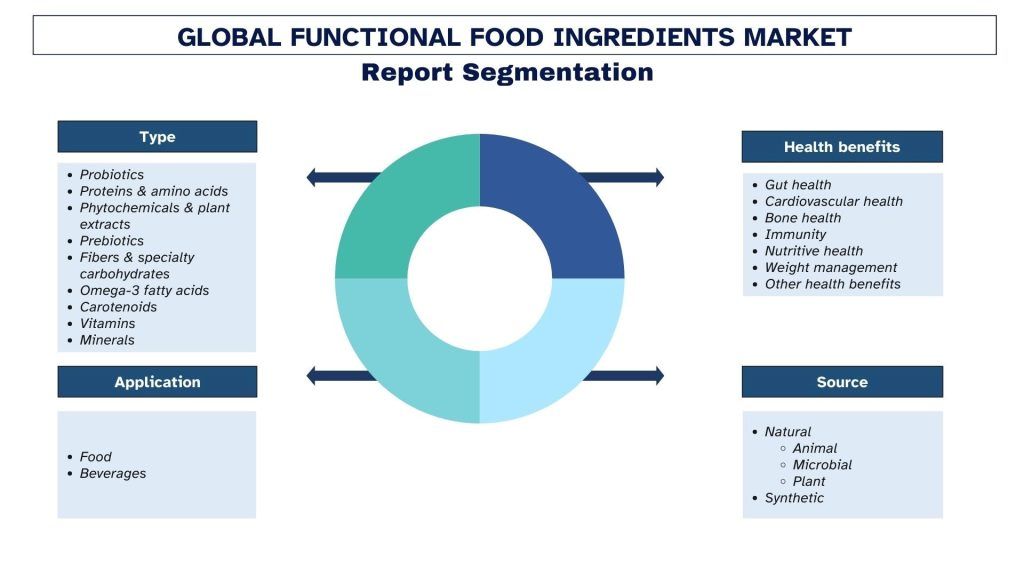
North America to hold a significant share of the market
North America will dominate the Functional Food Ingredients market on account of the increase in demand for high-priced fortified nutritional food & beverage products in the region. The application of food ingredients is estimated to increase at a faster pace in the region due to its demand among consumers. In addition, the changing customers’ lifestyles are also propelling the growth of the functional food industry in the North American region. In addition, the rising awareness of functional food ingredients due to the rising food allergies is also deriving market growth.
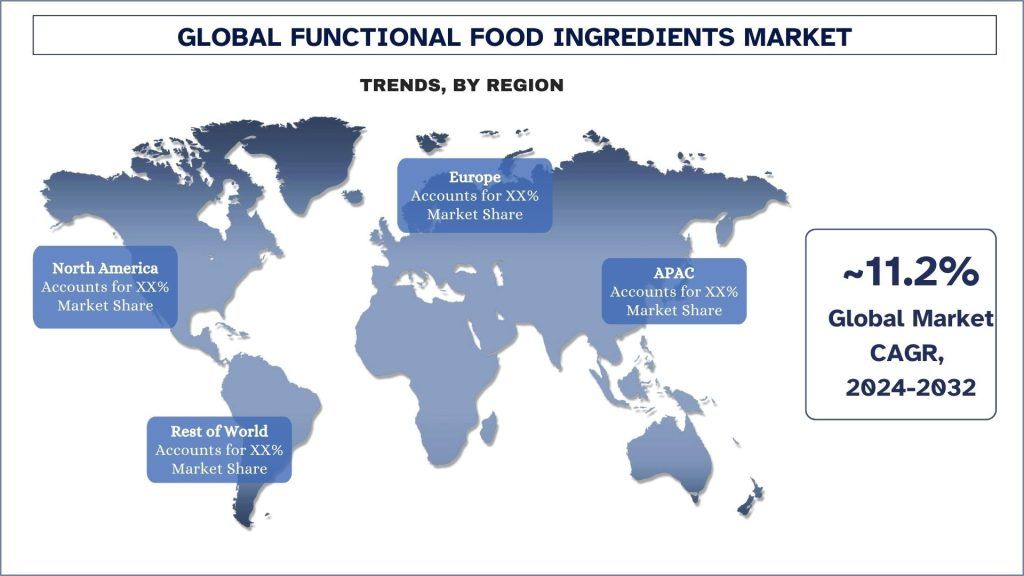
Functional Food Ingredients Industry Overview
Functional Food Ingredients is competitive, with several global and international market players. The key players are adopting different growth strategies to enhance their market presence, such as partnerships, agreements, collaborations, new product launches, geographical expansions, and mergers and acquisitions. Some of the major players operating in the market are Amway, Archer Daniels Midland Company, Arla Foods, BASF SE., Cargill Inc, DSM NV., General Mills Inc, Herbalife., Ingredion Incorporated, and Kerry Group PLC. Several M&As along with partnerships have been undertaken by these players to facilitate customers with hi-tech and innovative products/technologies.
Recent Developments
- In 2024, Arla Foods Ingredients introduced new functional water concepts at Vitafoods Europe, meeting consumers’ demand for health-focused beverages. Such products as Lacprodan ISO. WaterShake provides nutrient balanced diet sales with extra functional contents. Arla also presents a protein bar and medical nutrition powder illustrating the importance of the whey protein.
Functional Food Ingredients Market Report Coverage
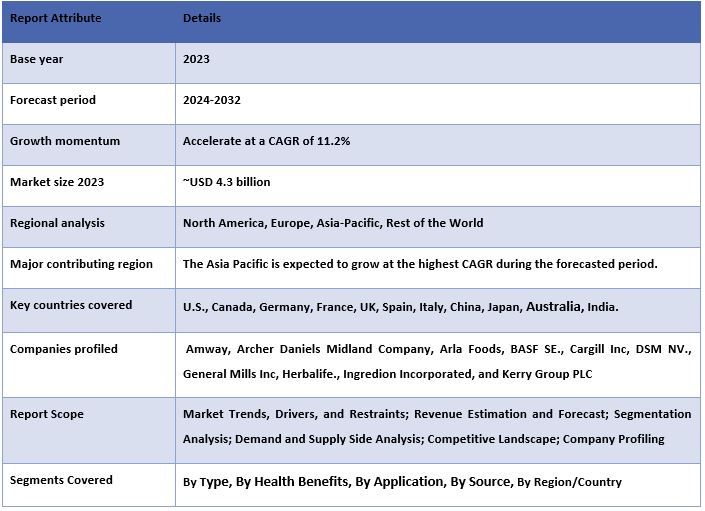
Reasons to buy this report:
- The study includes market sizing and forecasting analysis validated by authenticated key industry experts.
- The report presents a quick review of overall industry performance at one glance.
- The report covers an in-depth analysis of prominent industry peers with a primary focus on key business financials, product portfolios, expansion strategies, and recent developments.
- Detailed examination of drivers, restraints, key trends, and opportunities prevailing in the industry.
- The study comprehensively covers the market across different segments.
- Deep dive regional level analysis of the industry.
Customization Options:
Global Functional Food Ingredients can further be customized as per the requirement or any other market segment. Besides this, UMI understands that you may have your own business needs; hence, feel free to connect with us to get a report that completely suits your requirements.
Table of Content
Research Methodology for the Functional Food Ingredients Market Analysis (2022-2032)
Analyzing the historical market, estimating the current market, and forecasting the future market of the global Functional Food Ingredients market were the three major steps undertaken to create and analyze the adoption of Functional Food Ingredients in major regions globally. Exhaustive secondary research was conducted to collect the historical market numbers and estimate the current market size. Secondly, numerous findings and assumptions were taken into consideration to validate these insights. Moreover, exhaustive primary interviews were also conducted, with industry experts across the value chain of the global Functional Food Ingredients market. Post assumption and validation of market numbers through primary interviews, we employed a top-down/bottom-up approach to forecasting the complete market size. Thereafter, market breakdown and data triangulation methods were adopted to estimate and analyze the market size of segments and sub-segments of the industry. Detailed methodology is explained below:
Analysis of Historical Market Size
Step 1: In-Depth Study of Secondary Sources:
A detailed secondary study was conducted to obtain the historical market size of the Functional Food Ingredients market through company internal sources such as annual reports & financial statements, performance presentations, press releases, etc., and external sources including journals, news & articles, government publications, competitor publications, sector reports, third-party database, and other credible publications.
Step 2: Market Segmentation:
After obtaining the historical market size of Functional Food Ingredients, we conducted a detailed secondary analysis to gather historical market insights and share for different segments & sub-segments for major regions. Major segments are included in the report, such as type, health benefits, application, source, and region. Further country-level analyses were conducted to evaluate the overall adoption of testing models in that region.
Step 3: Factor Analysis:
After acquiring the historical market size of different segments and sub-segments, we conducted a detailed factor analysis to estimate the current market size of the Functional Food Ingredients market. Further, we conducted factor analysis using dependent and independent variables such as type, health benefits, application, source, and Functional Food Ingredients regions. A thorough analysis was conducted of demand and supply-side scenarios considering top partnerships, mergers and acquisitions, business expansion, and product launches in the Functional Food Ingredients market sector across the globe.
Current Market Size Estimate & Forecast
Current Market Sizing: Based on actionable insights from the above three steps, we arrived at the current market size, key players in the global Functional Food Ingredients market, and market shares of the segments. All the required percentage shares split and market breakdowns were determined using the above-mentioned secondary approach and were verified through primary interviews.
Estimation & Forecasting: For market estimation and forecast, weights were assigned to different factors including drivers & trends, restraints, and opportunities available for the stakeholders. After analyzing these factors, relevant forecasting techniques i.e., the top-down/bottom-up approach were applied to arrive at the market forecast for 2032 for different segments and sub-segments across the major markets globally. The research methodology adopted to estimate the market size encompasses:
- The industry’s market size, in terms of revenue (USD) and the adoption rate of Functional Food Ingredients across the major markets domestically
- All percentage shares, splits, and breakdowns of market segments and sub-segments
- Key players in the global Functional Food Ingredients in terms of products offered. Also, the growth strategies adopted by these players to compete in the fast-growing market
Market Size and Share Validation
Primary Research: In-depth interviews were conducted with the Key Opinion Leaders (KOLs), including Top Level Executives (CXO/VPs, Sales Head, Marketing Head, Operational Head, Regional Head, Country Head, etc.) across major regions. Primary research findings were then summarized, and statistical analysis was performed to prove the stated hypothesis. Inputs from primary research were consolidated with secondary findings, hence turning information into actionable insights.
Split of Primary Participants in Different Regions
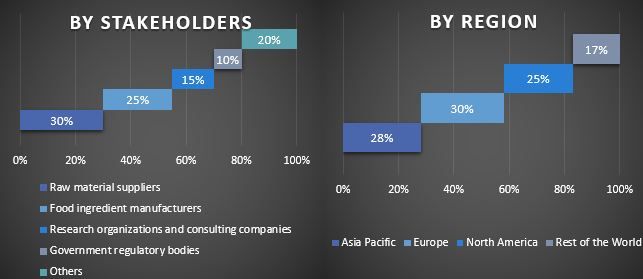
Market Engineering
The data triangulation technique was employed to complete the overall market estimation and to arrive at precise statistical numbers for each segment and sub-segment of the global Functional Food Ingredients. Data was split into several segments and sub-segments after studying various parameters and trends in the type, health benefits, application, source, and regions of the global Functional Food Ingredients market.
The main objective of the Global Functional Food Ingredients Market Study
The current & future market trends of global Functional Food Ingredients were pinpointed in the study. Investors can gain strategic insights to base their discretion for investments on the qualitative and quantitative analysis performed in the study. Current and future market trends determined the overall attractiveness of the market at a regional level, providing a platform for the industrial participant to exploit the untapped market to benefit from a first-mover advantage. Other quantitative goals of the studies include:
- Analyze the current and forecast market size of the Functional Food Ingredients market in terms of value (USD). Also, analyze the current and forecast market size of different segments and sub-segments.
- Segments in the study include areas of type, health benefits, application, source, and regions.
- Define and analyze the regulatory framework for the Functional Food Ingredients
- Analyze the value chain involved with the presence of various intermediaries, along with analyzing customer and competitor behaviors of the industry.
- Analyze the current and forecast market size of the Functional Food Ingredients market for the major regions.
- Major countries of regions studied in the report include Asia Pacific, Europe, North America, and the Rest of the World
- Company profiles of the Functional Food Ingredients market and the growth strategies adopted by the market players to sustain in the fast-growing market.
- Deep dive regional level analysis of the industry
Frequently Asked Questions FAQs
Q1: What is the global Functional Food ingredient's current size and growth potential?
Q2: What are the driving factors for the growth of global Functional Food ingredients?
Q3: Which segment has the largest share of the global Functional Food Ingredients by type?
Q4: What are the emerging technologies and trends in global Functional Food Ingredients?
Q5: Which region will dominate global Functional Food Ingredients?
Related Reports
Customers who bought this item also bought

